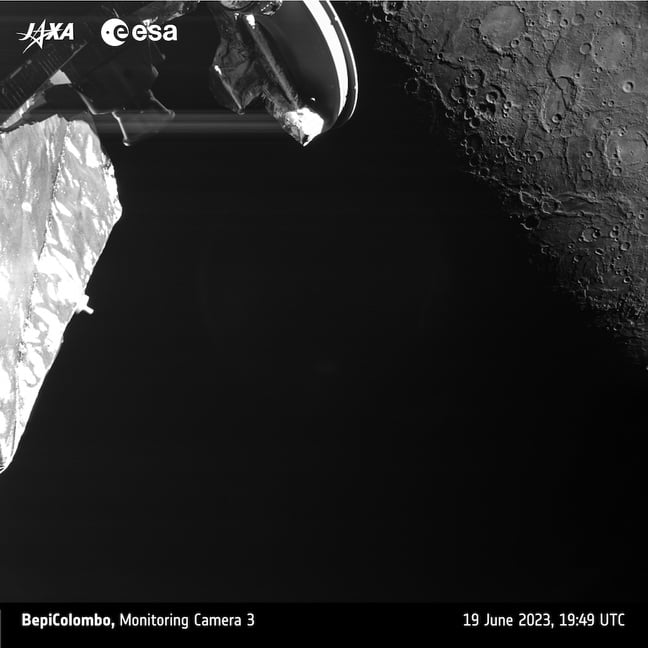BepiColombo probe turns to the dark side … of Mercury
Sends home snaps on third fly-by of six as it heads for orbit in 2025
The BepiColombo probe has completed its third fly-by of the planet Mercury and sent home some striking snaps of the tiny world's dark side.
The probe was launched in 2018 on a complex path that saw it fly by Earth (twice) and Venus (once) and calls for six encounters with Mercury before settling into orbit. All the maneuvering takes time because, as the European Space Agency explains here, entering orbit around the closest planet to the Sun is difficult thanks to massive gravity accelerating any spacecraft's velocity.
BepiColombo had already made its passes past Earth and Venus, plus a pair of Mercury visits.
On Tuesday it made its third approach, on a trajectory designed to bring it within just 236km of the surface. This pass saw BepiColombo visit Mercury's night side, which – as the planet's day lasts 176 terrestrial turnarounds – sees a lot of darkness.
The swoop went as planned, and BepiColombo has already beamed back three snaps of the dark, lifeless rock. Here's the closest the ESA has to a close-up of Mercury.

Mercury as seen from the BepiColombo probe taken about 15 mins after close approach June 20 – Click to enlarge
"Rising out of the night side this shadowy view … accentuates the heights of snaking tectonic scarps and the depths of craters," the ESA tweeted.
On its site, the European agency revealed the probe spotted a previously unobserved 218km-wide peak-ring impact crater that's been named “Manley” in homage to Jamaican artist Edna Manley (1900–1987).
The flyby also captured images of "Beagle Rupes" – described as "a slab of Mercury's crust that has been thrust westwards by at least 2km over the adjacent terrain."
- ESA and JAXA release Mercury eyecandy, courtesy of spacecraft BepiColumbo
- BepiColombo probe swings by Earth on way to Mercury – the Solar System's must-visit coronavirus-free resort
- Corona coronavirus hiatus: Euro space agency to put Sun, Mars probes in safe mode while boffins swerve pandemic
- NASA's Messenger craft SMASHES into Mercury: See ya later, alien crater
BepiColombo will next pass Mercury in September 2024, then again in December of the same year, followed by a sixth visit in January 2025. In December 2025 it will settle in Mercury orbit and split into two craft: the Mercury Magnetospheric Orbiter (MMO) and the Mercury Planetary Orbiter (MPO). Japan's Aerospace Exploration Agency (JAXA) developed the MMO.
The two orbiters are expected to spend around a year gathering data that will hopefully advance understanding of how Mercury evolved, the nature of its interior and composition, the extent and disposition of its magnetosphere, and the processes that formed its surface.
ESA and JAXA boffins will also use the visit to test Einstein's Theory of General Relativity by measuring the spacecraft's orbit and position. ®

 Biting the hand that feeds IT
Biting the hand that feeds IT